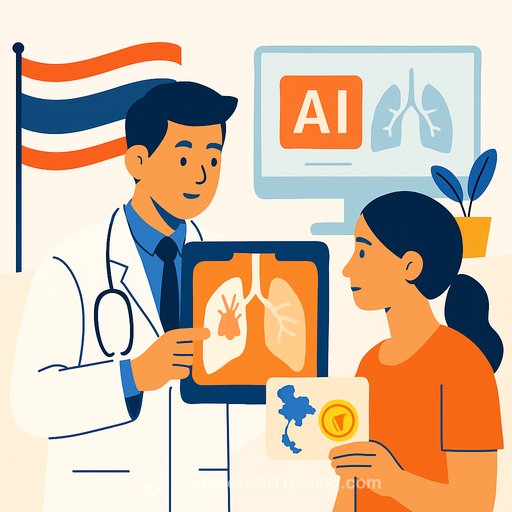AI lung cancer screening in Thailand: Practical steps for healthcare teams
Thailand is integrating AI into chest X-ray screening for early-stage lung cancer across the public system. The service is now covered by the "30 baht gold card" and available at 167 public hospitals, improving diagnostic speed and accuracy while easing pressure on clinicians.
The move targets a clear problem. Lung cancer is the second leading cause of cancer-related deaths in Thailand, with 17,222 new cases annually and 40 deaths per day. Most patients are diagnosed at stage 4, and many are non-smokers-an important shift that requires broader screening criteria.
What's being deployed
Hospitals are adopting AI-assisted chest X-rays (CXR-AI) as a low-cost, widely accessible entry point. This approach helps triage patients for confirmatory testing, supports overburdened teams, and can flag other conditions such as tuberculosis.
Partnerships under the Lung Ambition Alliance have already screened over 660,000 people with AI tools from Perceptra and Qure.AI. The CXR-AI developed with the Faculty of Medicine Siriraj Hospital has recognition from the Royal College of Radiologists of Thailand and regulatory approval in Thailand and Singapore, and was added to the Thai innovation product list in December 2023.
Funding and rollout
- Phase 1 (FY2025): 167 hospitals, budget of 55 million baht per year.
- Phase 2 (FY2026): 445 hospitals, budget of 135 million baht per year.
- Phase 3 (FY2027): 887 hospitals, additional budget of 225 million baht per year.
The plan strengthens access at small hospitals without specialists and large centers with heavy workloads. It also expands screening to populations often missed-non-smokers, younger patients, and people in remote areas.
Clinical impact
AI improves case finding by prioritizing suspicious films, reducing missed diagnoses, and shortening time to treatment. For teams stretched thin, it standardizes first-pass reads and supports faster triage, while keeping final decisions with clinicians.
Implementation checklist for hospital leaders
- Run local validation on your hospital's data to confirm performance in your setting; recalibrate thresholds as needed.
- Define protocols: who gets CXR-AI, what scores trigger urgent review, and when to escalate to LDCT and biopsy.
- Set up oversight: radiologist review, audit trails, and regular performance monitoring (sensitivity, specificity, false positives).
- Integrate into workflow: PACS/RIS connectivity, alerting, and clear referral pathways to lung clinics.
- Train staff: radiology, ED, primary care, and nurses on indications, interpretation, and limitations.
- Educate the public: simple messages on early detection and eligibility, with targeted outreach to non-smokers and remote communities.
- Track outcomes: time-to-diagnosis, stage shift at detection, TB detections, treatment initiation time, and patient experience.
- Governance: data protection, informed consent where applicable, bias checks across demographics, and incident response plans.
Screening strategy: LDCT and CXR-AI
LDCT remains the gold standard but is costly and limited in availability. CXR-AI offers a practical front line in Thailand: use it to broaden access, then escalate positive cases to LDCT and multidisciplinary review.
Equity and trust
Trust determines adoption. Be transparent about benefits and limits, involve patients in service design, and publish outcome data. Specialized lung clinics, clear clinical pathways, and continuous feedback from patients will make the system work on the ground.
Environmental exposure matters. With rising concern over PM2.5, expanding screening beyond smoking history is prudent, especially for at-risk communities and hard-to-reach areas. See WHO guidance on air pollution and health for context: WHO: Air pollution and health.
Operational tips
- Start with a pilot unit (radiology + ED or primary care), then scale after 60-90 days of stable metrics.
- Use standardized reporting with AI scores and confidence levels to reduce ambiguity.
- Schedule weekly multidisciplinary huddles to review AI-flagged cases and near-misses.
- Budget for ongoing maintenance, updates, and periodic revalidation.
Bottom line for healthcare teams
AI-assisted CXR can move diagnoses earlier, support overworked clinicians, and improve access at scale. Success depends on strong protocols, local validation, patient engagement, and relentless measurement. With the NHSO rollout and funding in place, now is the time to prepare teams, workflows, and data systems for sustained performance.
Build AI literacy across your team
If you need structured upskilling for clinical and operations staff adopting AI tools, explore curated options by role: AI courses by job.
Your membership also unlocks:






